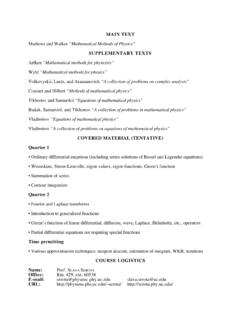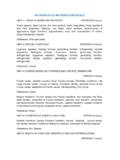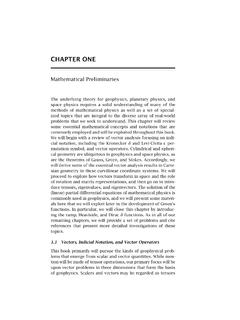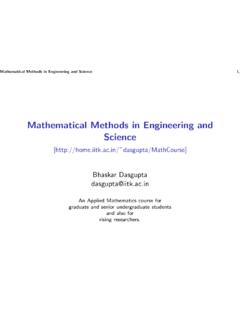Transcription of Mathematical Methods of Physics - Cornell University
1 Physics 562: Statistical MechanicsSpring 2002, James P. SethnaHomework 4, due Wednesday, April 3 Latest revision: April 12, 2002, 11:23 ReadingDavid Chandler, Introduction to Modern Statistical Mechanics , chapter , chapters 6 & , Lectures on Physics volume III, chapter 4 Problems( )Solving the Diffusion Equation.(Optional: for those for whom Fourier andGreens function Methods are unfamiliar.)If needed: Matthews and Walker, Mathematical Methods of Physics , Chapter p. 242-245 (Diffusion Equation).Consider a one-dimensional diffusion equation / t=D 2 x2, with initial conditionperiodic in space with periodL, consisting of a function at everyxn=nL: (x,0) = n= (x nL).(a) Using the Greens function method, give an approximate expression for the the density,valid at short times and for L/2<x<L/2, involving only one term (not an infinitesum). (Hint: how many of the Gaussians are important in this region at early times?)(b) Using the Fourier method, give an approximate expression for the density, valid atlong times, involving only two terms (not an infinite sum).
2 (Hint: how many of thewavelengths are important at late times?)(c) Give a characteristic time in terms ofLandD, such that your answer in (a) is validfort and your answer in (b) is valid fort .1( )Coarse-Grained Magnetic needed: Matthews and Walker, Mathematical Methods of Physics , Chapter 12 (Calculusof Variations).A one-dimensional magnet above its critical point is described by a free energy densityF[M]=(K/2)( M)2+(B/2)M2whereM(x) is the variation of the magnetization with position along the single coordinatex. The average magnetization is zero, and the total free energy of the configurationM(x)isF[M]= F[M] Methods we developed in class to find the correlation functions and susceptibilitiesfor the diffusion equation can be applied with small modifications to this (mathematicallymore challenging) magnetic system.(a) Calculate the equilibrium equal-time correlation function for the magnetization,C(r,0) = M(r,0)M(0,0) .You ll want to know that the Fourier transform eikx/(1 +a2k2)dk=( /a)exp( |x|/a).
3 (b) Assume the magnetic order parameter is not conserved, and is overdamped, so the timederivative of M is given by the inverse viscosity times the variational derivativeof the free energy: M / t= F/ M. Mevolves in the direction of the totalforce on it. Here the average is over all future evolutions given the initial the Greens function forM,G(r, t) giving the time evolution of an initialconditionM(r,0) =G(r,0) = (r). (Hint: You can solve this with Fourier transformsas in class.)(c) Using the Onsager regression hypothesis and your answer to part (a), calculate thespace-time correlation functionC(r, t)= M(r, t)M(0,0) . (This part is a challenge:your answer will involve the error function.) If it s convenient, plot it for short timesand for long times: does it look like exp( |y|) in one limit and exp( y2)inanother?Calculate the susceptibility (r, t)fromC(r, t) (Chandler p. 257).2( )Phonons and Photons are and photons are the elementary, harmonic excitations of the elastic and electro-magnetic fields.
4 We ve seen in an earlier problem that phonons are decoupled harmonicoscillators, with a distribution of frequencies . A similar analysis shows that the Hamil-tonian of the electromagnetic field can be decomposed into harmonic normal modes problem will explain why we think of phonons and photons as particles, instead ofexcitations of harmonic modes.(a) Calculate the partition function for a quantum harmonic oscillator of frequency .(b) Calculate the grand canonical partition function for bosons multiply filling a singlestate with energy h .For = 0, show that the grand canonical partition functionfor bosons is the same as that for a quantum harmonic oscillator up to a shift in thearbitrary zero of the total energy of the Boltzmann filling of a harmonic oscillator is therefore the same as the Bose-Einsteinfilling of bosons into a quantum state, except for an extra shift in the energy of h /2. Thisextra shift is called thezero point energy.(c) A system hasNharmonic modes with frequencies k.
5 Show that the partition functionis the same as that of a grand-canonical system with zero point energy Nk=1 h k/2andNdistinguishable, non-interacting boson states with energy h kand chemicalpotential k= , the label for theNstates or modes in part (c) is the wavevectork( , for phononsin crystals and photons in vacuum or crystals). In this case, instead of thinking of thesystem asNbosons each with one state, we can think of it as one boson withNpossiblestates, with a dispersion relation (k). Real, massive bose particles likeHe4in free spacehave a similar dispersion relationEk= h2k2/2m: phonons and photons are thus Boseparticles with dispersion relationEk= h k.(d) Can phonons or photons Bose condense at low temperatures? Why not?Be careful not to get confused: Bose atoms in a harmonic potential can Bose condense(next problem), but a harmonic vibrational excitation of a collection of atoms cannot. Theformer has a fixed number of bosons with a variety of (equally spaced) available energystates: the latter is viewed as a variable number of bosons occupying a single energy ( )Bose Condensation in a Parabolic Potential.
6 Observation of Bose-Einstein Condensation in a Dilute Atomic Vapor , Anderson, Ensher, Matthews, Wieman, and Cornell ,Science269, 198 (1995). and Cornell in 1995 were able to get a dilute gas of rubidium-87 atoms to Bosecondense. (The first author was the post-doc Anderson: Ensher and Matthews were thegraduate students.)(a) Is rubidium-87 a boson or a fermion?(b) At their quoted maximum number density of 1012/cm3,atwhattemperatureTpredictcdo you expect the onset of Bose condensation in free space? They claim thatthey found Bose condensation starting at a temperature ofTmeasuredc= 170nK. Is thatabove or below your estimate?Bose-Einstein Condensation at 400, 200, and 50 nano-Kelvin, from Jila (above reference).The pictures are spatial distributions 60ms after the potential is removed; the field of viewof each image is 200 m 270 m. The left picture is roughly spherically symmetric, and istaken before Bose condensation; the middle has an elliptical Bose condensate superimposedon the spherical thermal background; the right picture is nearly pure condensate.
7 I believethis may not be the same experiment as described in their original trap had an effective potential energy that was harmonic in the three directions, butanisotropic with cylindrical symmetry. The frequency along the cylindrical axis was 120Hz,and the two other frequencies were smaller by a factor of 8. The Bose condensation was4observed by abruptly removing the trap potential, and letting the gas atoms spread out:the spreading cloud was imaged 60ms later by shining a laser on them and using a CCDto image the shadow.(c) What is the ground-state wave-function for one rubidium-87 atom in this potential?What is the wave-function in momentumspace? What is the predicted momentumdistribution for a classical oscillator atTpredictedc? What is the ratio of the momentumwidths along the axis and perpendicular to the axis for the ground state? For theclassical thermal distribution of momenta? If the potential is abruptly removed, whatwill the distribution of positions look like 60ms later, (ignoring the small width of theinitial distribution in space)?
8 Compare your predicted anisotropy to the false-colorimages above. If thexaxis goes mostly right and a bit up, and theyaxis goes mostlyup and a bit left, which axis corresponds to the axial frequency and which correspondsto one of the two lower frequencies?Their Bose condensation isn t in free space: the atoms are in a harmonic oscillator poten-tial. In the calculation in free space, we approximated the quantum states as a continuumdensity of statesg( ). That s only sensible ifkBTis large compared to the level spacingnear the ground state.(d) Compare h tokBTat the Bose condensation pointTmeasuredcin their a one-dimensional harmonic oscillator of frequency 0, it s clear thatg( )=1/( h 0):the number of states in a small range is the number of h 0 s it contains.(e) Compute the density of statesg( ) for a three-dimensional harmonic oscillator, withone frequency 0and two of frequency 1?Their experiment hasN=2 104atoms in the trap as it condenses.(f) By working in analogy with the calculation in free space, find the maximum num-ber of atoms that can occupy the three-dimensional harmonic oscillator potential inpart (e) without Bose condensation.
9 (You ll want to know 0z2/(ez 1)dz=2 (3) = ) According to your calculation, at what temperatureTHOcshould the realexperimental trap have Bose condensed? What is the classical density at the centerof the trap atTHOc? How does it compare with the Bose condensation density in freespace atTHOc? Actually, they first slowly reduced it by a factor of 75 and then abruptly reduced itfrom there; I m not sure why, but let s ignore that










